Monday, August 21, 2006
Inspecting the hive together
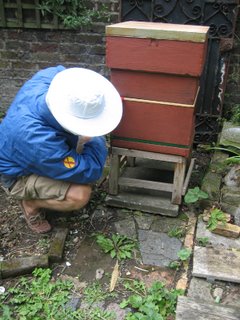 Brian looking at the hive.
Brian looking at the hive.I don't quite have all the gear - just a hat and veil- which may explain why I got stung. I think the bees were just saying hello.
The hive has the super added above the light line of wood. This line of wood is the queen excluder, stopping the queen from moving around the hive into the upper layers and laying her eggs in the comb. We are leaving the comb egg-free so we can collect the clean eggsless honey at the end of September.

The brood box with its 11 frames. The queen's in there somewhere. She's bigger than her workers but we've yet to find her. Not that easy to spot in amongst 50,000 bees!
The larger gap between the first frame and the hive box has been filled with comb.
The spacing of the frames has been designed so that the bees can make the wax comb deep enough for their use but also leave enough space between the frames for them to climb up and down between them.
 Alison with the proper all-in-one gear. No stings for her.
Alison with the proper all-in-one gear. No stings for her.She is lifting out one of the frames from the super for inspection.
This frame is on the end so it should be full of honey stores.
The whiteness of the comb means that the bees have stored lots of honey and capped the cells of with a little film of white wax.
Brian finally does some work!
 Saturday's weather was perfect for us to work on the beehive.
Saturday's weather was perfect for us to work on the beehive.We needed to add a couple more frames to the second super and generally have a look at the whole hive to make sure that all was well.
I started by assembling the frames. They hold the foundation which gives the bees a running start in the process of making the comb that they use for nurseries, larders and long term storage.
Each layer of the hive has 11 frames and on Saturday morning we had 3 layers in our hive. The brooding layer and 2 layers (the two supers) for honey storage.
Tuesday, August 15, 2006
Falling trees... again
We'll also have to sit down and read about how to harvest all this honey in September. That's the messy bit.
Adding the additional super
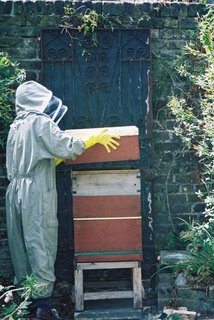

August 8 - all the frames in the super are now capped, so I add the 2nd one but with just 9 frames as Stamfordham (the mail order company) sent the wrong sized frames. As the bees seem to start their activities in the centre of the super I don't see what harm it will cause adding the two extra frames at the outer edges at the weekend.
Still not inspected the hive. I think I'm going to have to wait for Brian to get home before I do that, as there are now two supers to take off. It's all a bit much for one person to cope with, especially as the hive and the 2 supers are now nearly as tall as me.
He should be home from his marathon sailing expedition finally next week, hurrah.
He can do his share of the beecare.
Honey almost ready
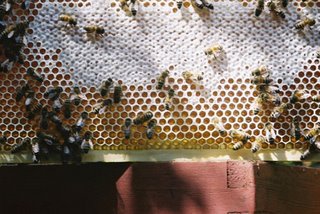
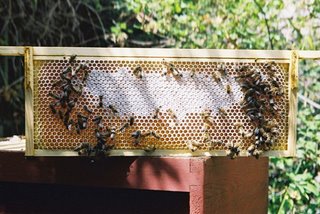
July 31 - The month-long heat wave officially ended today, and we may even get some showers this week so the bees may have more joy finding nectar and pollen.
I'm starting to really enjoy this. Much better when it's not boiling hot.
The middle frames are mostly capped now (see photos), but the outer frames are not capped at all so I don't think I need to add the additional super just yet.
Tried to open the hive but again stuck. I had vi sons of the whole thing toppling over if I try and prise it apart. Think I'll wait for Brian to get home before I attempt that. But I am aware that I do need to look in the hive for bugs as bees are very prone to disease these days and you have to watch out for mites and Verroa.
Second super on its way
Hot and bothered
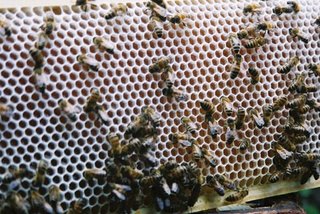

20 July - more than two weeks since I checked the hive/super. Not sure what I'm looking for and how to negotiate both the hive and the super. I call Bee man for advice (his wife doesn't seem too happy). If the honey is capped on all the frames then they need another super he tells me. Yes they are agitated because 36 C is far too hot for them. I wait until 7.30pm when it's a bit cooler to see what's going on. If they're cooler they won't get so angry when I open up their home is my reasoning. It proves right.
I see that the middle frame (above) is full of a light coloured honey liquid but none of it is capped yet.
The outer frames have a little honey and the bees are still working on them.
The hive and the super seem to be stuck together. I decide to leave the hive inspection to another day.
Brian's father to the rescue
Disaster strikes...almost
15 July - Woke up at 6am and for some reason looked out the window, and had a horrendous shock. The large shrub on the trellis at the back of the garden to the left of the hive had completely collapsed. I assumed it had flattened the hive and there were now 30,000 very angry homeless bees either caught under its branches or buzzing around west London in search of a new home. FUCK. I put on my suit and with some trepidation went to investigate unsure of what I would do if my fears were realised. To my huge relief and total surprise, the shrub had missed the hive by inches. It looked untouched. All that day the bees seemed agitated. They must have heard the shrub crash to the ground, it may even have made the hive jump. Coupled with the soaring temperatures - they are not happy...
Time to add a super?
 July 1 - extremely hot day. Didn't really want to get my suit on and open the hive but if they're getting pretty overcrowded in there they'd appreciate some extra space to hang out and make their honey, so I needed to check on them and add the super (extra box) if nec.
July 1 - extremely hot day. Didn't really want to get my suit on and open the hive but if they're getting pretty overcrowded in there they'd appreciate some extra space to hang out and make their honey, so I needed to check on them and add the super (extra box) if nec.I was looking to see if the outside frames had cells that were pretty much all capped. If so the bees would need the super with its new 11 shorter frames.
They had indeed capped most of the cells, so I put the queen excluder on top of the hive (to stop the queen getting into the super and laying eggs in there) and added the super with the 11 smaller frames (took ages making the frames - would help if my nails didn't bend), and put the crownboard - which I'm holding in the photo- on top of the super.
The first hive inspection


 June 20 - I have left the bees for almost two weeks without looking in the hive as one of the things the cameraman told me was if you keep disturbing their home they might fly away to find a more peaceful one. I have seen them come and go from the entrance (pictured), not in a big black cartoon-style cloud, but just a continuous stream. The weather has been dry and hot so they'd be out foraging for food.
June 20 - I have left the bees for almost two weeks without looking in the hive as one of the things the cameraman told me was if you keep disturbing their home they might fly away to find a more peaceful one. I have seen them come and go from the entrance (pictured), not in a big black cartoon-style cloud, but just a continuous stream. The weather has been dry and hot so they'd be out foraging for food. Bee man agrees to come over to show me what to look for when I do my first hive inspection. The books have photos and diagrams but I figured it would be a lot easier if he showed me once. Take off the roof of the hive, followed by the crownboard (pictured) which is placed on top of the frames.
It was amazing - could see amber, grey, and green (which are different types of pollen) cells all round what must be the larvae cells as they are pearly white. Some of the cells in the frames near the centre of the hive were capped - this means the larvae has hatched. Saw some honey in the cells at the top of the frames. We took out each of the 11 frames (pictured) looking for the queen but couldn't find her, in amongst those 1000s of bees. There are certainly a frightenly large number of them.
Everything going according to plan i.e. queen laying lots and lots of eggs and workers foraging for the pollen and nectar to feed the larvae which are then turning into more worker bees.
Bee man reckons in a week's time I might be able to add the first super (where the bees will make the honey for me) on top of the hive.
Bees first world cup
 Still getting the hang of the smoker. That hessian Brian bought burns really well when it gets going.
Still getting the hang of the smoker. That hessian Brian bought burns really well when it gets going.